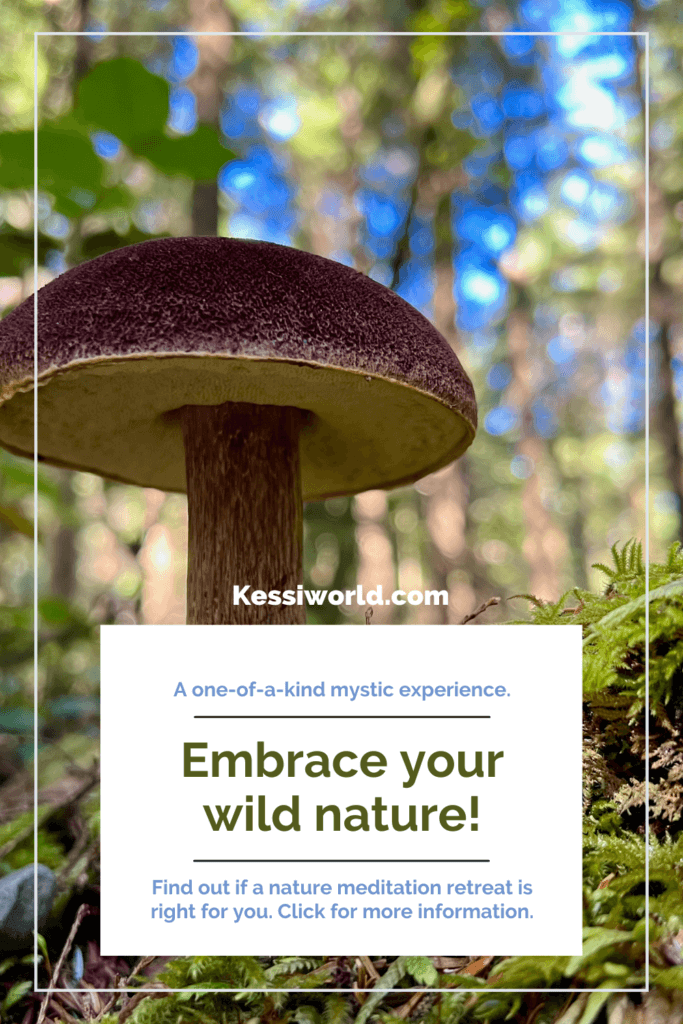
Oregon is famous for natural diversity and Central Oregon hosts something for just about everyone. The famous variety of attractions cater perfectly to outdoor enthusiasts of all octane levels. Often overlooked is the other-worldly wonderland of the John Day Fossil Beds National Monument and the fascinating drive that offers an up-close and personal connection to this colorful, untamed part of the world.
Sequestered amongst morsels of a vast canyon system, the Monument in Oregon brings to life an ancient time capsule. The unique geological site tells the story of diverse ecosystems — from tropical forests to swamps to savanna — existing here before mounds of lava were smothered over most of the Pacific Northwest like thick icing on a sheet cake. Erosion over millions of years would etch away at the layers, leaving behind fascinating formations, oozing color and texture.
This article will help you plan the best drive to experience the John Day Fossil Beds National Monument

Be sure to read to the bottom of this piece to find the Interactive Map, complete with key restaurants and places to stay, as well as interesting sights along the way. The map also charts the itinerary for a great 3-day tour of the area, which can easily be shortened or lengthened to accommodate your needs. We added this trip to a week-long visit amongst other things to do in Central Oregon, but there are many ways to make it work.
While a day trip to the Painted Hills is a great use of time, the longer version covering all three units of the John Day Fossil Beds really invites in mindful connection to these ancient nuggets of Oregon’s natural history. The final section at the bottom of this article has all the details needed to customize your trip. And remember, if you need more planning ideas, ask away, I aim to help: [email protected]
Since we visited every trail in all three units of the National Monument, I wrote an article detailing all the trails in the John Day Fossil Beds, with even more specific trail information.
Breakdown of our John Day Fossil Beds drive
- Who the heck was John Day?
- Starting out on our road trip
- Thundereggs
- Ghost towns
- Clarno Unit of John Day Fossil Beds
- Fossil, Oregon
- Sheep Rock Unit of John Day Fossil Beds
- Blue Basin Overlook Trail
- Picture Gorge
- Mitchell, Oregon
- Painted Hills Unit of John Day Fossil Beds
- Other things to do in Central Oregon
- If you go — planning resources
- Interactive Map
- Download a checklist
Who the heck was John Day?
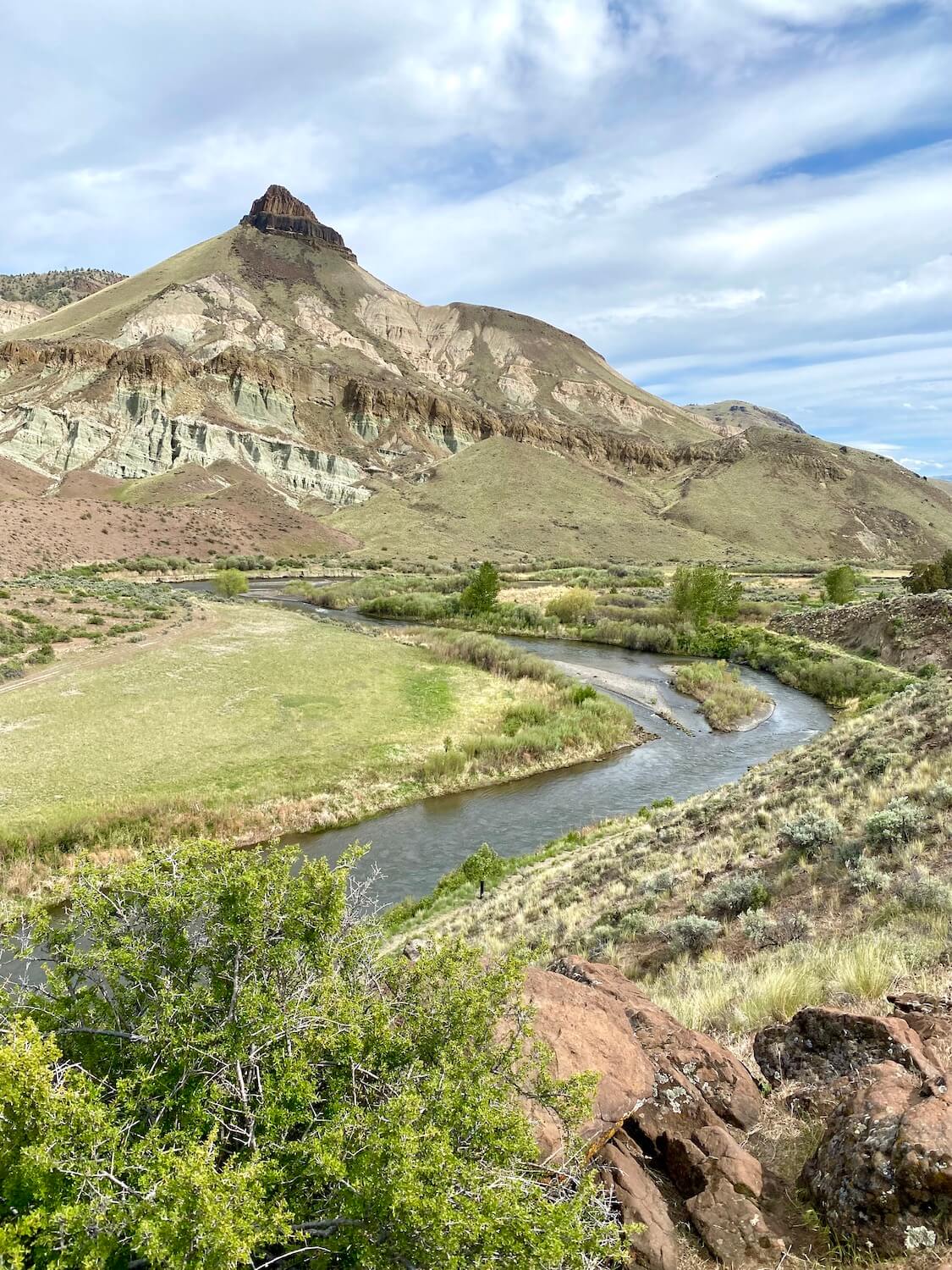
John Day is a household name in these parts, largely because a river and two small towns (John Day & Dayville) are named for the early fur trader — working in this part of the world around 1812. He was known to hang out near a certain section of the waterway which eventually became “John Day’s area,” then broadened to the entire 284-mile river — cementing his place on Oregon’s map.
In the mid-1900s geologists started finding significant fossils amongst the winding canyons around the river which eventually led to the formation of the John Day Fossil Beds National Monument in 1975. Much of the land was already part of active ranches, so the Monument is carved into three units: Clarno, Sheep Rock & Painted Hills. Most of the John Day Fossil Beds is within or closely adjacent to quiet Wheeler County, the least populated county in the State of Oregon with a modest 1,500 citizens.
Let’s get started — 3 day epic drive of John Day Fossil Beds National Monument
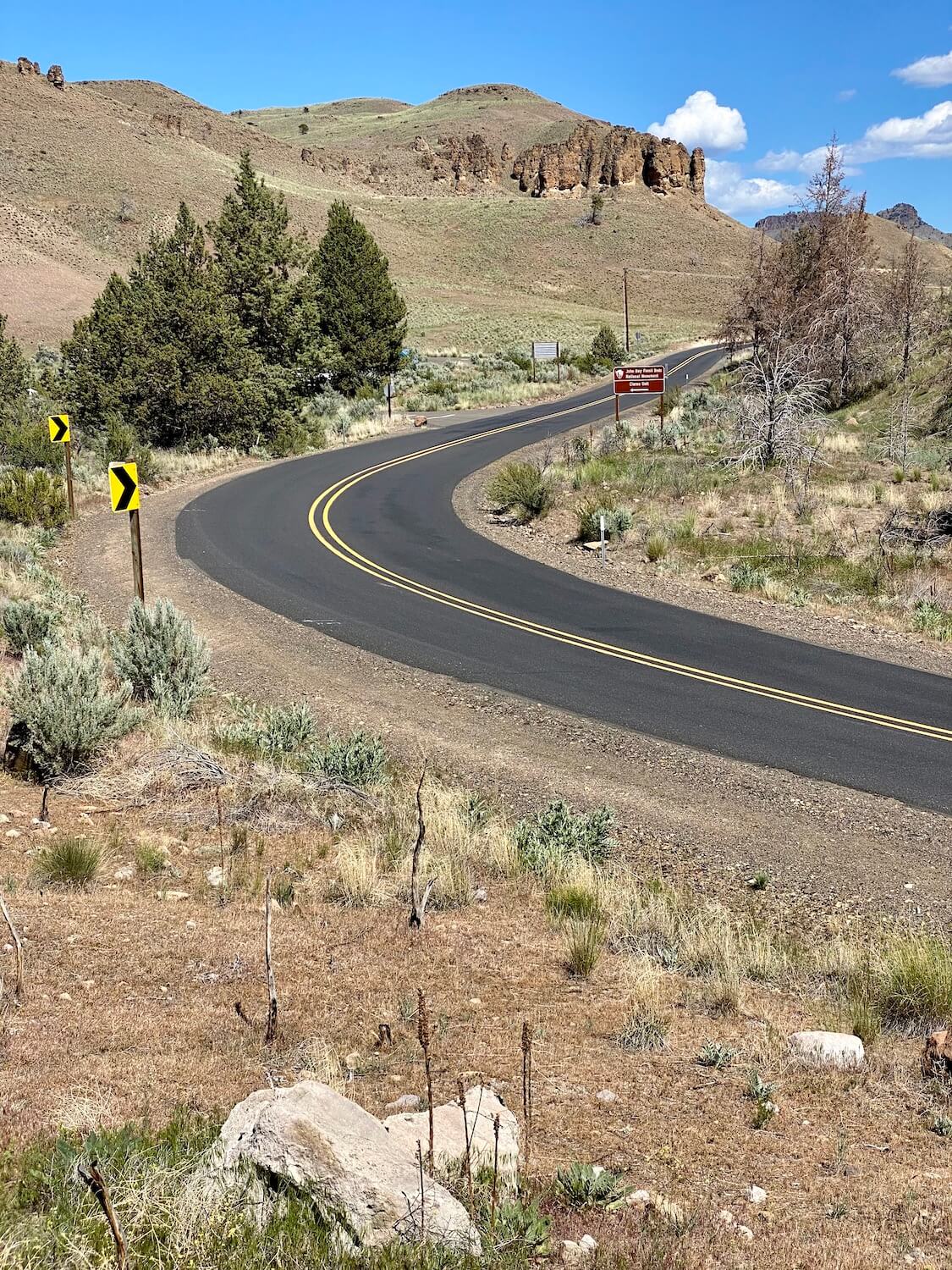
My friend Dave and I awake at a reasonable hour from our lodging in Bend, Oregon, ready for adventure. We enjoy a hearty breakfast at Simba Restaurant in Downtown Bend before jumping in a rental car. The drive north on Highway 97 offers inspiring views of the snow-covered peaks of the Cascade Mountains, including the Three Sisters and Mt. Jefferson, all to the West. While the Bend and Redmond roadways are a bit congested, the highway begins to open up beyond the turnoff to Smith Rock State Park. The scene is stunning with wide-open views of rolling farmland framed in by crisp profiles of well-known volcanoes — Mt. Hood even peeking her head out in the far distance.
Madras, Oregon is the last town we approach with any sizable services. It is also the gateway to Lake Billy Chinook Recreation Area as well as the Warm Springs Indian Reservation. We stop at a Safeway on the edge of town and fill a cooler with ice and provisions for the day and evening. It happens to be a Tuesday and most rural restaurants seem to be closed on this day of the week. I’ve learned by that experience backup food and drink is an important consideration when traveling in rural areas of the Pacific Northwest. We also grab extra water to replenish our reusable bottles along the way.
Thundereggs at Richardson’s Rock Ranch

Just nine miles out of town we turn off the main highway toward a dusty country road that meanders through ranch land. Eventually, we stumble upon a picturesque red barn that beckons us toward the driveway leading to Richardson’s Rock Ranch. We are greeted by several flippant peacocks, throwing up their blue and green feathers while squawking in a language between them, likely, “Here come the tourists!”
The state rock of Oregon is the thunderegg, a geode prevalent in the region due to the abundance of volcanic activity over thousands of years. The baseball-sized “eggs” were created under ideal circumstances — bubbles of molten lava cooking mixtures of ash, mineral, moisture, and other debris to create wild shapes and patterns.
I’m fascinated by the variety of stones from all over the world. There are raw and polished thundereggs available that were mined on the premises in addition to just about any other rock imaginable. The indoor gift shop provides a large table with local finds as well as a dedicated geode museum.
Finding a local thunderegg that calls to me, I ask the women at the counter for more information. She’s cranky but extremely likable and shares with me there is an extra baby geode adjacent to the patterns I find so appealing. Soon enough it’s joining us in the rental car and we’re back on the road.
Two different kind of ghost towns lurk ahead — Shaniko and Antelope
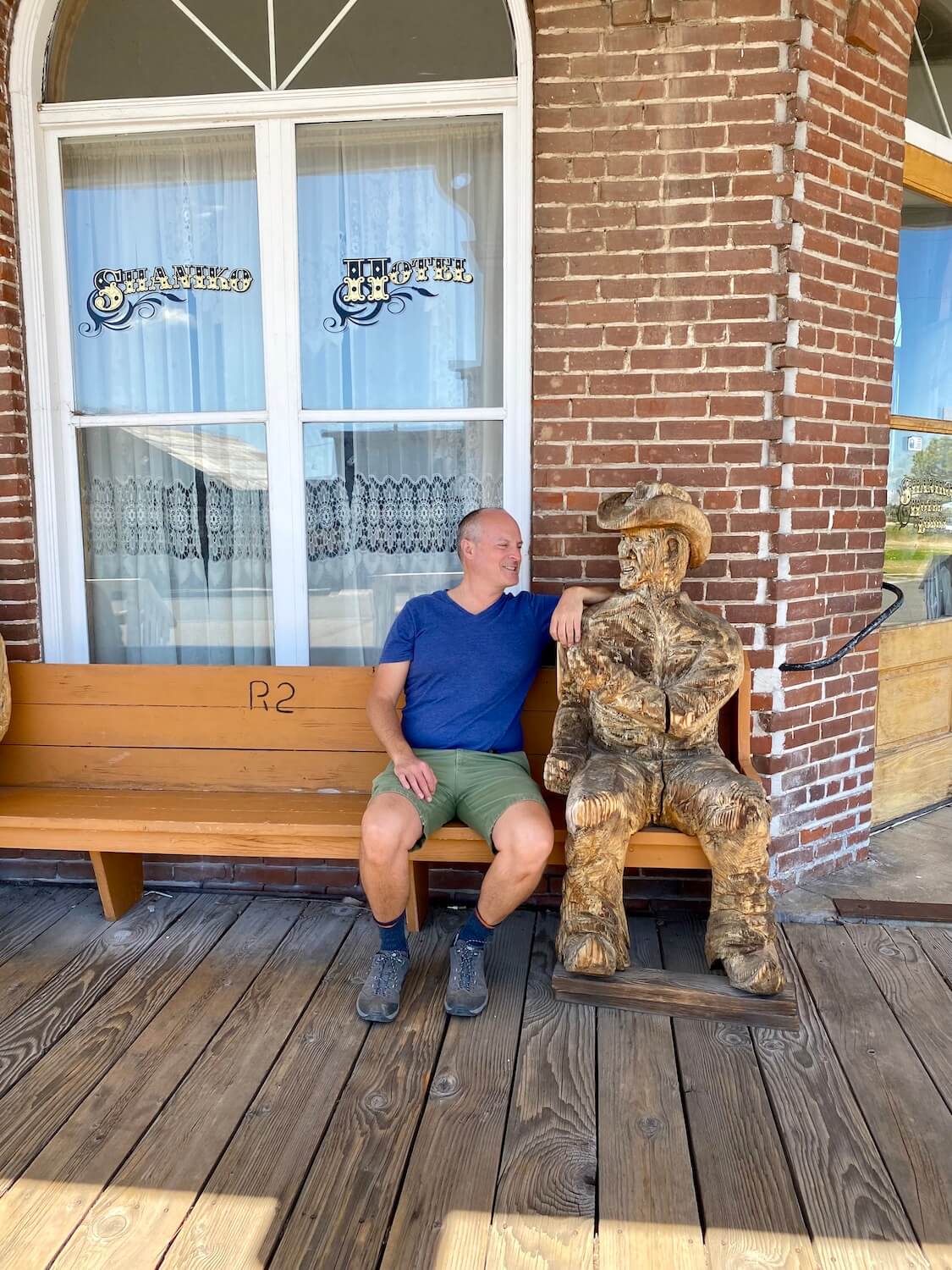
Highway 97 is the North/South arterial, called The Dalles – California Highway because… well, it connects the two. The dry rolling hills are peaceful and scenic in their own way and it feels like the blue sky goes on forever. After a few bends in the road, we come upon Shaniko, Oregon, the former wool capital of the US.
Shaniko had importance in the early 20th century as the key goods depot for Central Oregon until better rail services bypassed this area. Today, the streets are ghostly quiet, including the handsome, and defunct, Shaniko Hotel at the epicenter. A plethora of other Western town buildings could be right off the Universal Back Lot in Hollywood, and we have the wide “sheep herding” streets to ourselves to explore.
We wander through a few mini-museums and find the post office open. A curio store newly in business sells Tillamook ice cream so we add a few dollars into the tiny local economy. Another mercantile along the main highway is also open and features an eerily eclectic variety of goods — from Doritos to lace napkins. We decide to top off the tank and come to realize that gas is $6/gallon at this quaint outpost. Good thing we only need a few gallons!
This is our turn off the main highway, and the road toward Fossil (Highway 218) begins the rural wind to another kind of ghost town. Antelope, Oregon, population 82, became famous in the 1980s for the Rashneesh community that developed under the guidance of the Bagwan Shree Rashneesh. The Netflix series “Wild Country” offers a view into this bizarre slice of history.
Growing up in Oregon at that time, I remember the headlines. Today this one-street burg feels like the spirits of that wild period of history are still trapped. The former Zorba the Budha restaurant, which apparently served excellent food, is quiet but still visibly marked with the red “Z” bricks underneath wide glass windows highlighting the vacant feeling of the town.
Stunning scenic beauty leading to the Clarno Unit of John Day Fossil Beds

This part of Highway 218 is among the most scenic drives in all of Oregon. The flowing topography seems to morph to something even more stunning with each hairpin bend in the road. It’s no wonder Harley-Davidson and Porsche touring clubs visit this area every Summer — the well-maintained and perfectly engineered road leans in all the right ways to support intrepid country driving.
Just after the bridge that crosses the John Day River, we arrive at the Clarno Unit of the John Day Fossil Beds. The parking area is well-maintained with clean restrooms and functioning water fountains. The towering canyon ridge features a prominent profile against the vivid blue sky and is full of fossils — mostly leaves. We hike 700 vertical feet to a bridge in the rock made by petrified wood from a log jam when this was water (photo above).
The Clarno Unit of the monument is the smallest and offers a great introduction to the area. It’s a relatively quick and easy stop and then we’re on our way to Fossil, Oregon.
County Seat — Fossil, Oregon
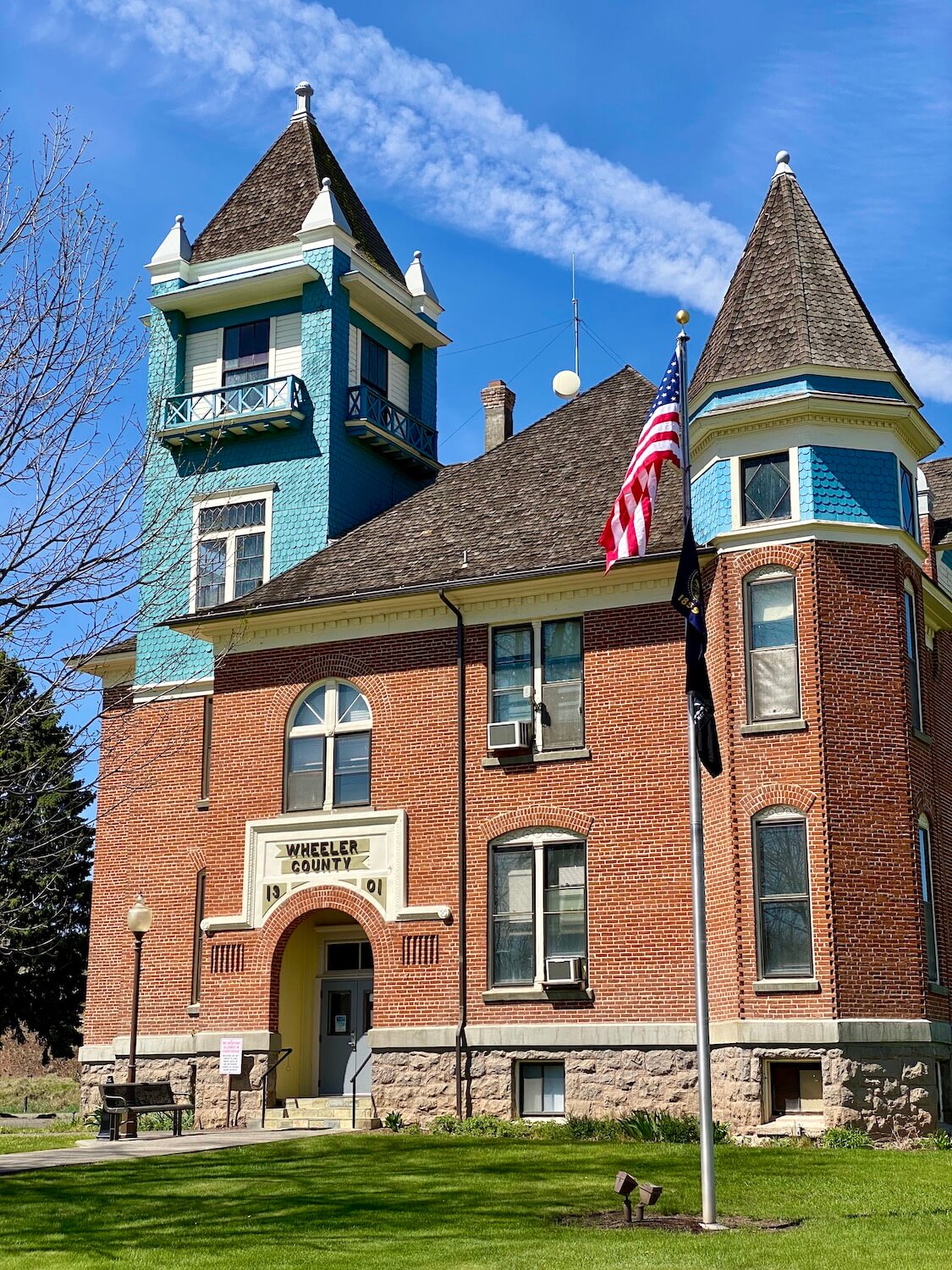
Fossil, Oregon is the largest community in Wheeler County and also the seat of government here. A cursory driving tour includes several churches and the stately County Courthouse that seems to exude the importance of the town. The grid is small and soon enough we’re settling into our Bed and Breakfast, Hyatt House. This is the real version of Bed and Breakfast and a great lodging option in Fossil. We can easily walk the two blocks to the main intersection of town that features the mercantile, bakery, restaurant, and liquor store.
There is also a place behind the local High School where we can dig for our own ancient relics. The mercantile sells a compact excavating kit, complete with a pick and brush. Since it closes at 6 pm — and everything else seems to be closed on Tuesdays — we return to our B&B and raid our cooler to dine alfresco. By the way, even though we brought our own food, the store had plenty of options for great picnic supplies, including a locally made salsa that was delicious.
Sheep Rock Unit of the John Day Fossil Beds National Monument
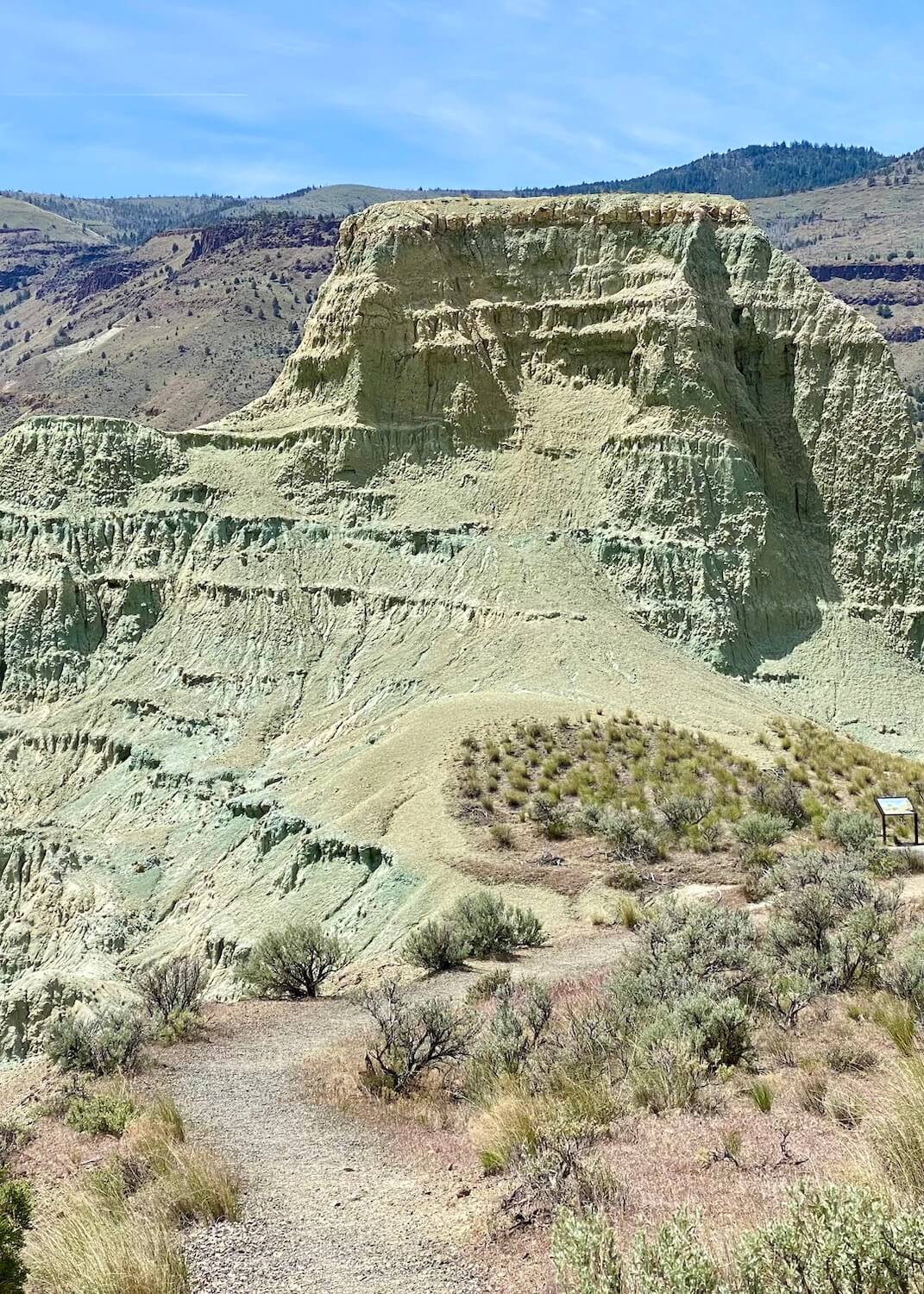
The next day we enjoy breakfast at our B&B and drop by to see my friend John for coffee at the mercantile. We chat about life in a tiny Central Oregon community and he talks about his experience moving from Portland two years earlier. Small town life seems to fit him, and I can understand the appeal of a place where people support and look after one another, all amongst dramatic natural beauty and stillness.
We roll on down the river and make a turn at the juncture known as Kimberly. Up the road is an orchard that operates a fruit stand in the Summer season. Eventually, we find ourselves driving in the irrigated valley that follows the John Day River between ridges. The Sheep Rock Unit is composed of a few different turn-offs. I’ve written an in-depth article about all the trails of the John Day Fossil Beds, which provides specific details.
The Foree Trailhead is first and we’re particularly drawn to the Story in Stone Trail (photo above), with the most magical greenish-blue mound of ancient clay crumbles. We learn that each horizontal line in the formation represents an explosive volcanic event in Oregon’s history. A bench is placed at the perfect viewing location atop the trail, making it easy to sit back and ponder the ancient design featured just a stone’s throw away.
Blue Basin Overlook Trail
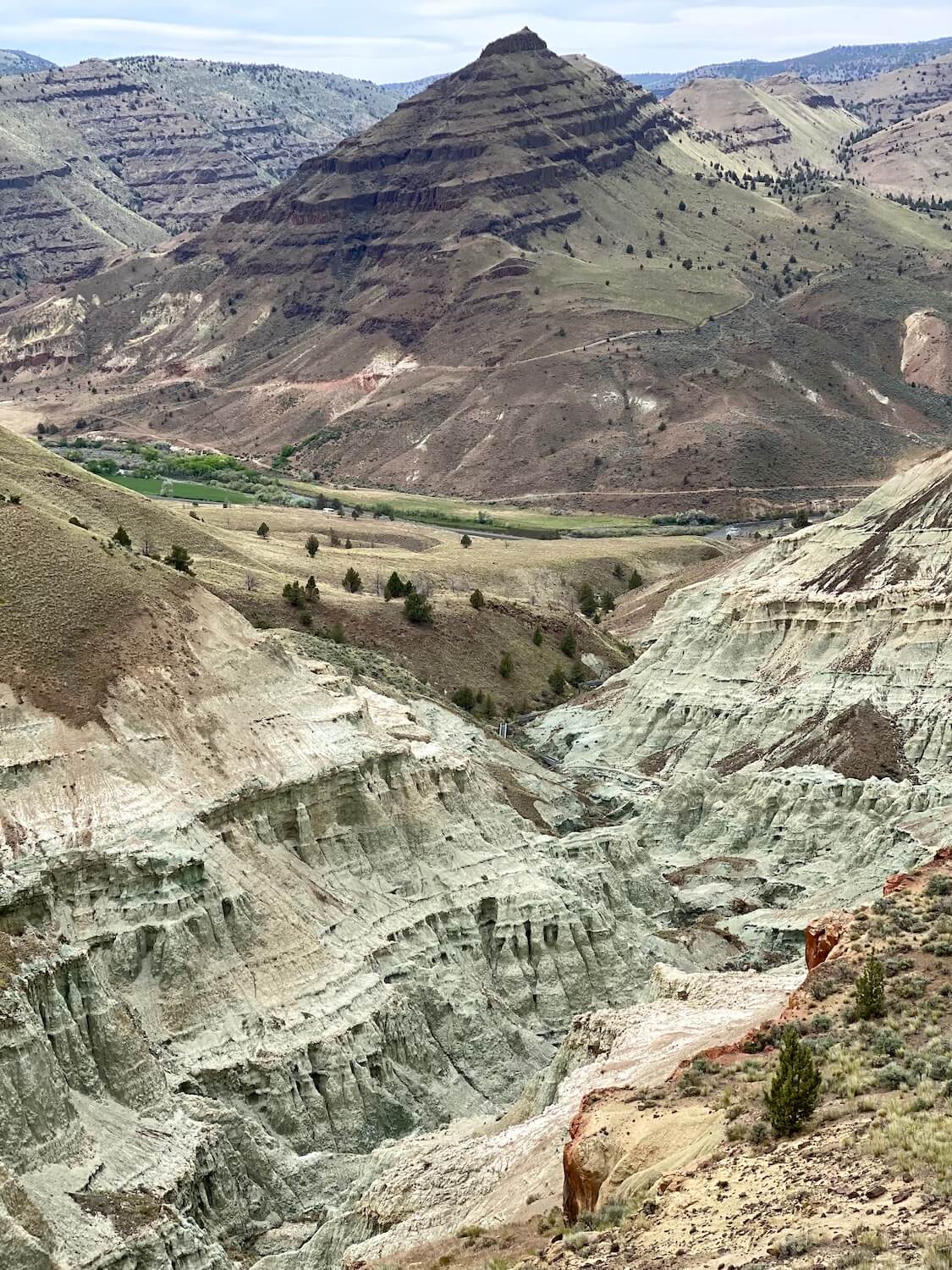
Back in the car, we pass statuesque Cathedral Rock, right along the John Day River, and soon after exit the road to the Blue Basin parking area. There are three versions of the trail that survey a unique canyon with flowing pastel veins of crumbly volcanic clay. We push on to the most challenging terrain covered in the Blue Basin Overlook Trail.
The 760-foot elevation gain over about 3.5 miles gets our blood moving, and I’m thankful for the scattered clouds above that create some distraction for the pounding midday sun. It’s beginning to get hot, so I’m glad we have plenty of water. We hike the trail in a clockwise fashion and soon enough disappear into a forested ravine. We traverse boardwalks and encounter steep hills covered with wildflowers on the trek toward what feels like the sky.
About halfway into the hike, panoramic vistas appear with a birdseye view of the Blue Basin. Blueish-green layers formed by compacted ash put on an impressive show providing evidence of countless volcanic events over millions of years. This experience connected to such “other-worldly” beauty becomes our favorite hike of the three-day road trip.
John Day Fossil Beds surprise — the picturesque Picture Gorge
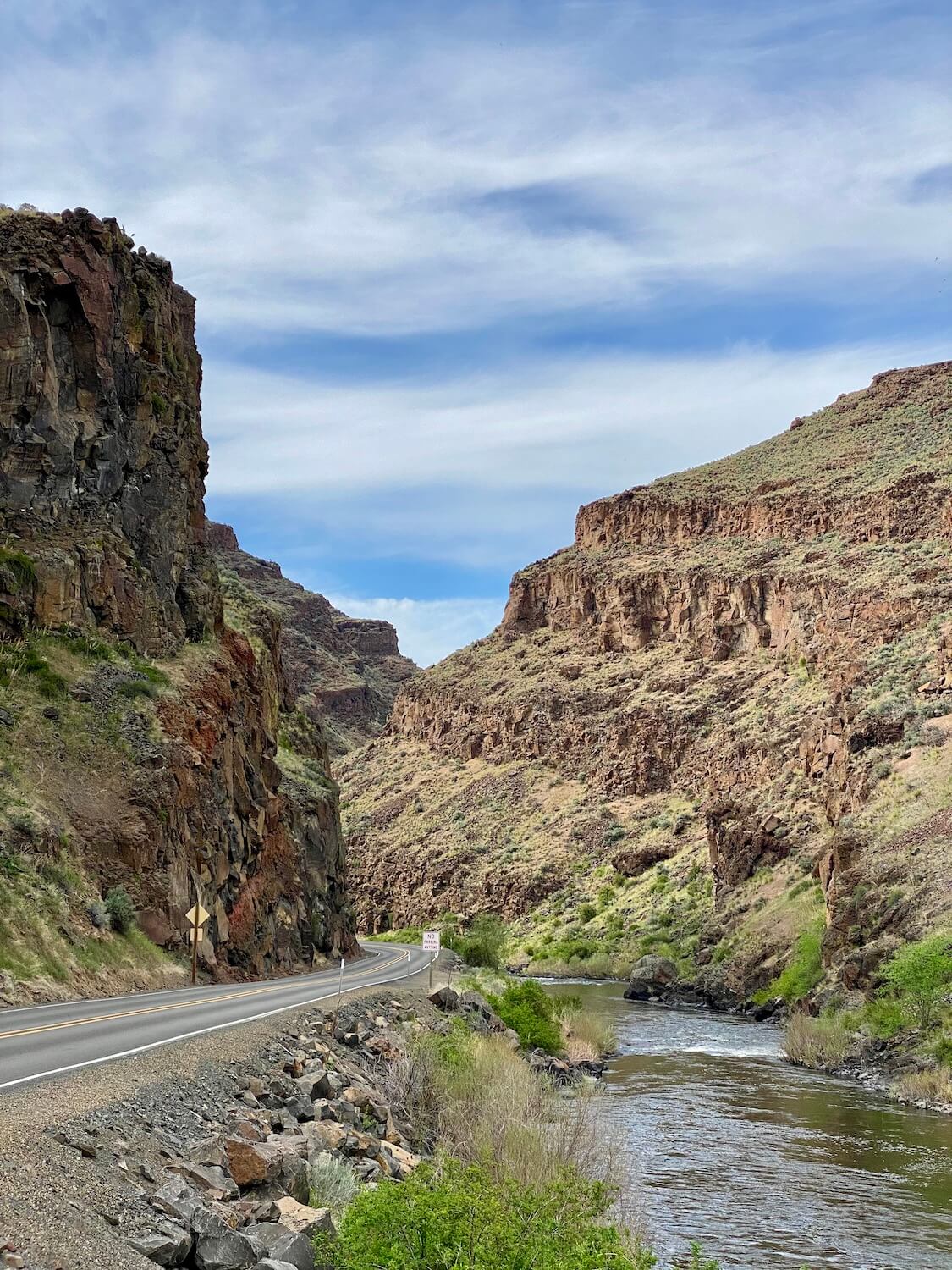
Souls nourished, we continue to the Historic Cant Ranch. David is interested in the sheep farming machinery, and the displays relay information about the wool industry that was prevalent here in the early 20th century. A jaunt up the Sheep Rock Overlook Trail opens up to the perfect view of the giant formation towering over the entire valley, featuring the gentle flow of the John Day River.
We’re not expecting this surprise, but our drive to the Mascall Formation Overlook wanders through the Picture Gorge, which, while not named because of the scenery, is in fact ridiculously picturesque. Highway 26 hugs the side of jagged basalt walls while the river chugs along on the other — working for thousands of years to erode away this mysterious canyon. Green moss and sage line the rocky slopes to the top of the ridge like fuzz on a tomato vine, and the curving road demands my complete attention.
Mitchell, Oregon
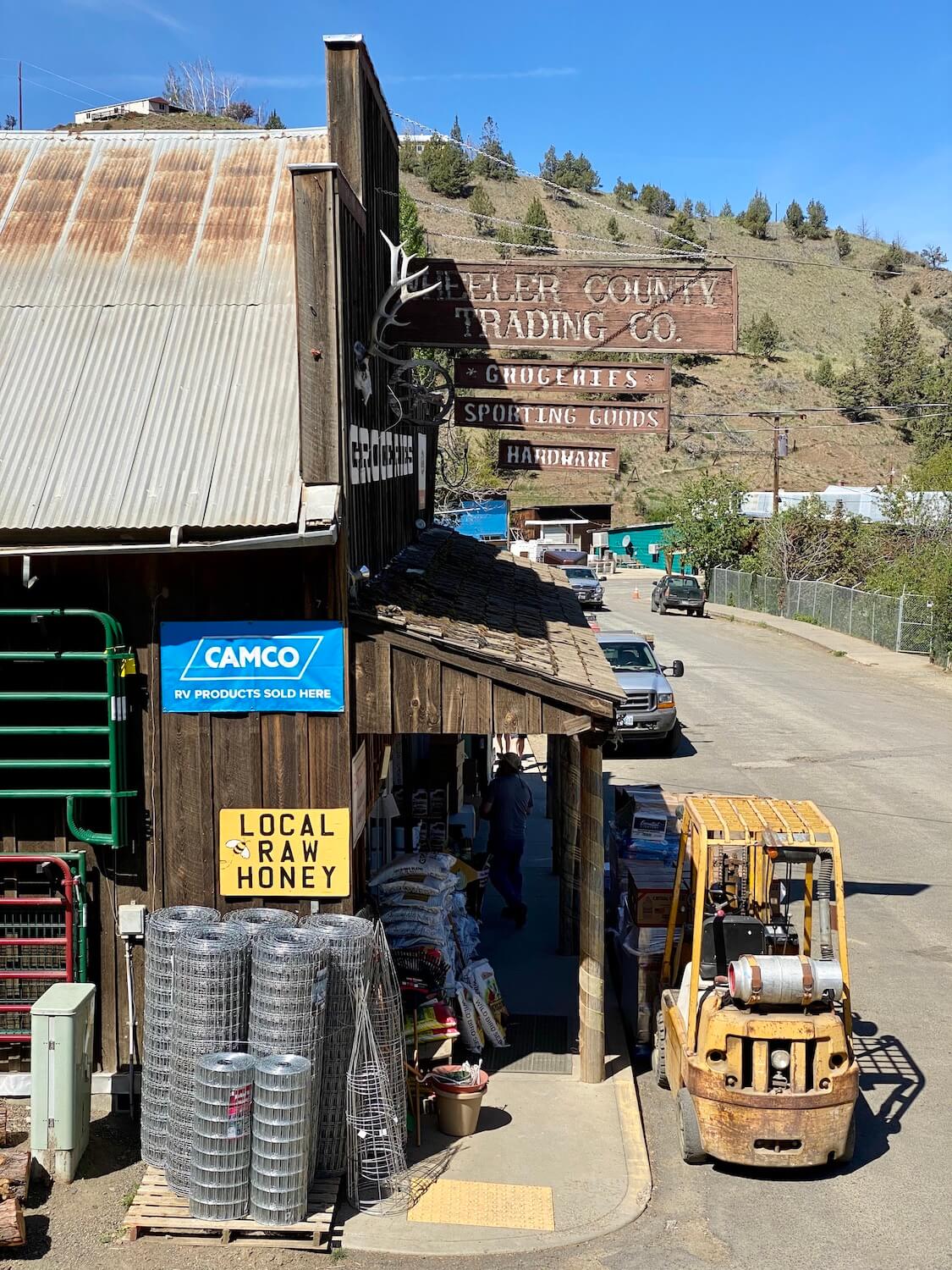
Our shoes are covered in ancient volcanic dust and hearts full of Fossil Beds viewing as we pull into tiny Main Street of Mitchell, Oregon. The yellow glow of the sun begins to make its heavy fall from the sky. Our Airbnb is the entire upper floor of an old-West building that was built around 1900 — at the intersection between the Feed & Seed and Wheeler County Mercantile. From my balcony I imagine the sheriff walking down the middle of the street to draw a gun in a shootout.
We mosey down Main Street toward the rich oasis of Tiger Town Brewing, where outstanding food and drink commence. Eric, one of the three owners, prepares smokey manhattans and other delicious concoctions that invite us to enjoy our own modern-day “saloon” experience. Amongst food and drink that would hold its own in Seattle or Portland, the potato salad is award-winning. As luck would have it, the woman who makes it for the restaurant comes in to pick up a to-go order of Tiger’s delicious fish and chips. She comments on her love for Seattle and we chat about the difference between life in the Emerald City compared to the slower pace of rural Oregon.
This feels like being a guest in someone’s home, the way the characters come and go and share glimpses of their perspectives with us. This is my second visit to Tiger Town Brewing and it will not be my last — a vibrant community hub with great food, drink, and local color.
The Painted Hills Unit of John Day Fossil Beds
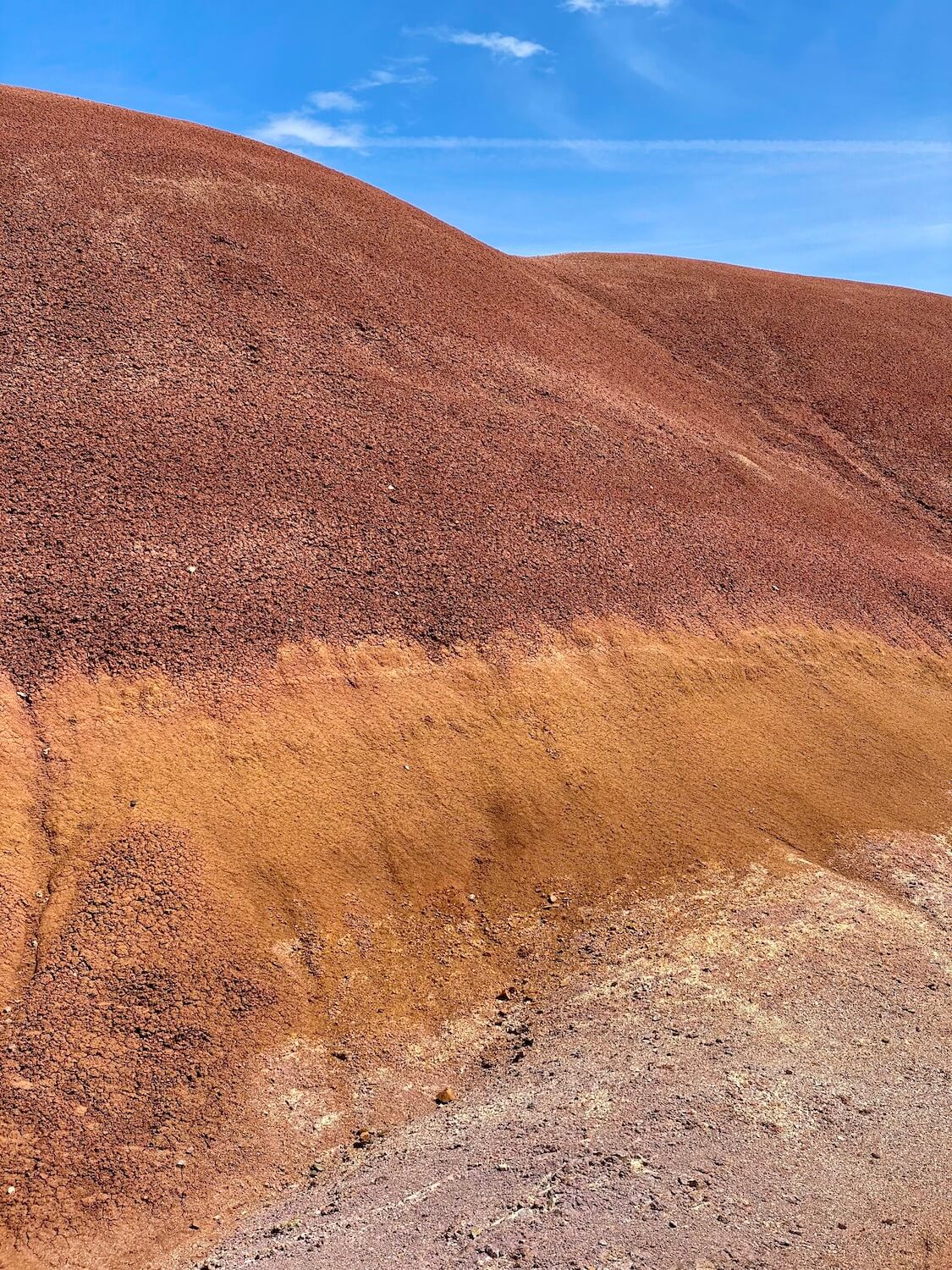
Thanks to the delicious evening in town, we get a late start to the day and an early lunch is enjoyed at Dayville Cafe, about 30 miles the other direction. The food is made with love — especially the variety of homemade pies — and worth the drive back through the Picture Gorge.
We’re in for a treat at the Painted Hills, because little yellow flowers are in bloom amongst many other varieties in and around the National Monument. No matter the time of year, there are always unique nuances.
The rolling folds of Technicolor feel alive — always changing under different lights. The colors are each impressive time capsules, representing different organic material entombed over millions of years and then revealed through hard-working erosion.
We work from the back of the acreage to the front, starting with the Red Scar Knoll and ending up at the iconic Painted Hills Overlook Trail. The textures and color do not disappoint, and there are plenty of opportunities for new photos to add to my growing collection. We wander for about three hours before it’s time to head back to the “other” world outside the Monument.
The Painted Hills Unit of the John Day Fossil Beds National Monument is so inspiring I have two other articles featuring the showstopping geological wonder of Oregon. For more photos and detailed information click each link:
Other things to do in Central Oregon
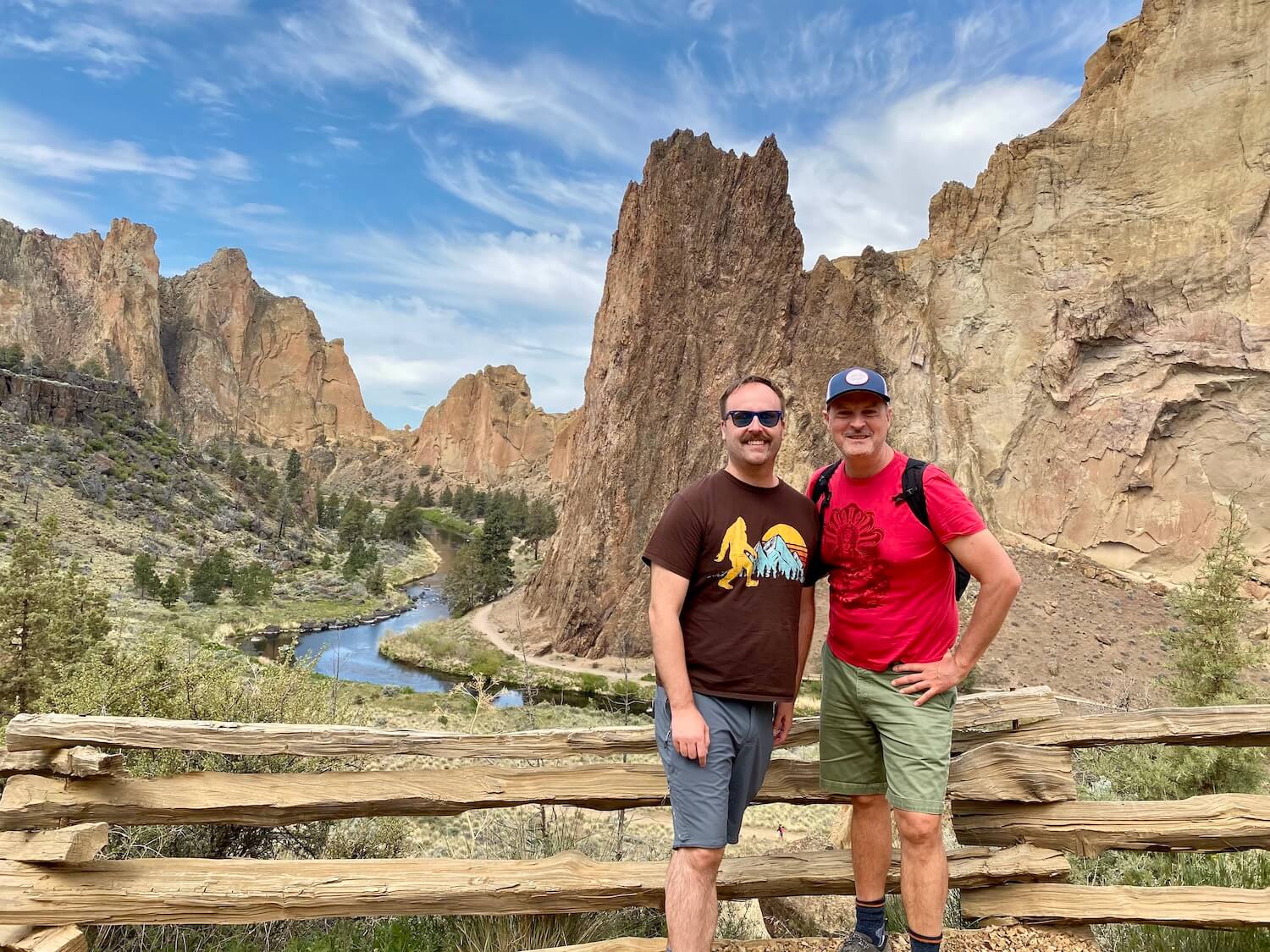
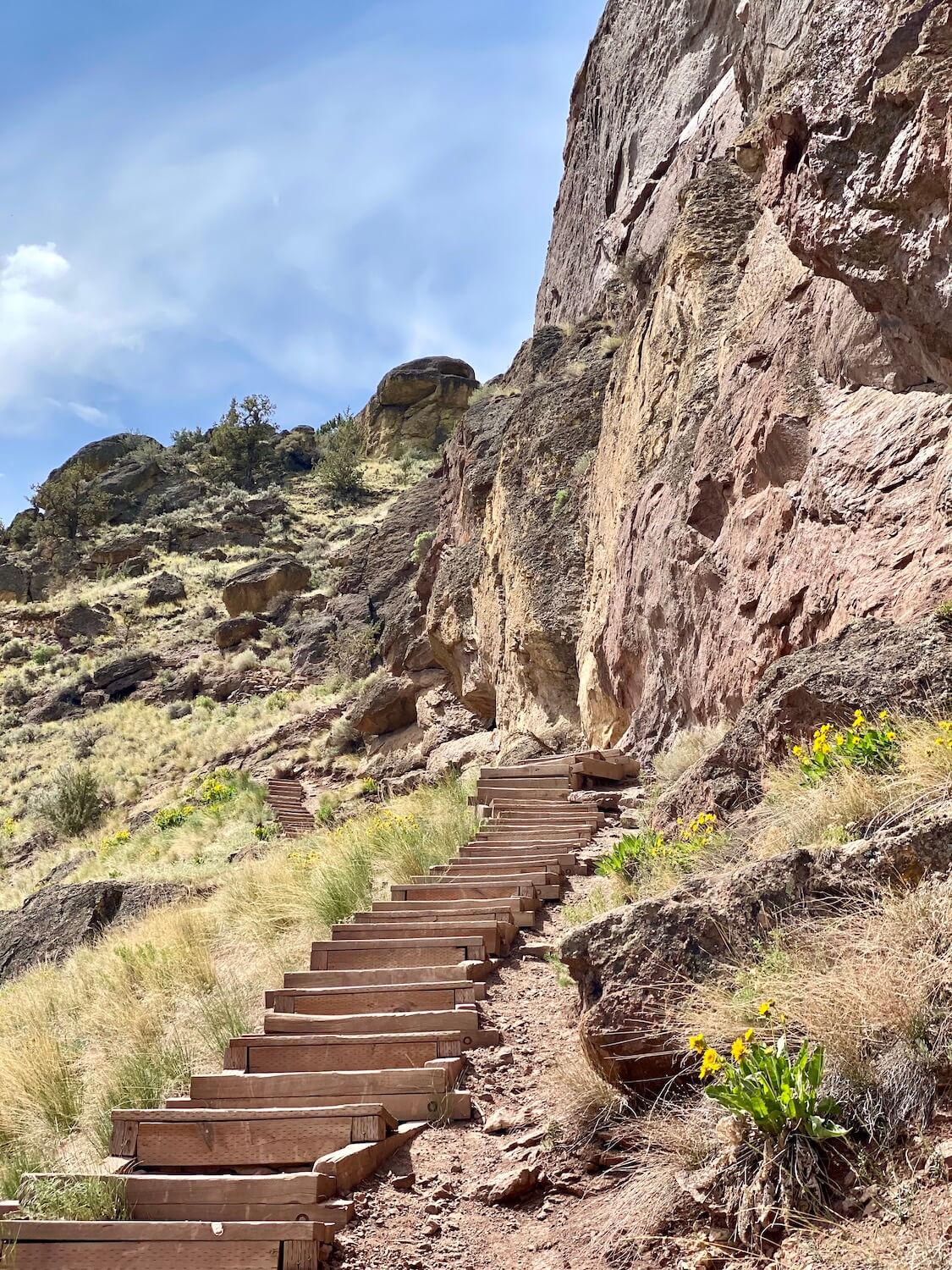
We return to our vehicle to complete the John Day Fossil Beds drive, heading through the Ochoco National Forest and via Prineville toward the SCP Redmond Hotel. Although this 3-day epic loop is over, we remain in the area for a bit longer and enjoy some of my favorite things to do in Bend, Oregon, including an invigorating hike up the Misery Ridge Trail at Smith Rock State Park.
The area is abuzz with options, but it’s eventually time to board our Alaska Airlines flight back to Seattle. This reminds me, being an airline geek, I wrote an article about ways to use Alaska Airlines miles for quick trips throughout the Pacific Northwest, which includes this memorable destination and the John Day Fossil Beds drive.
If you go — helpful tips for visiting John Day Fossil Beds National Monument
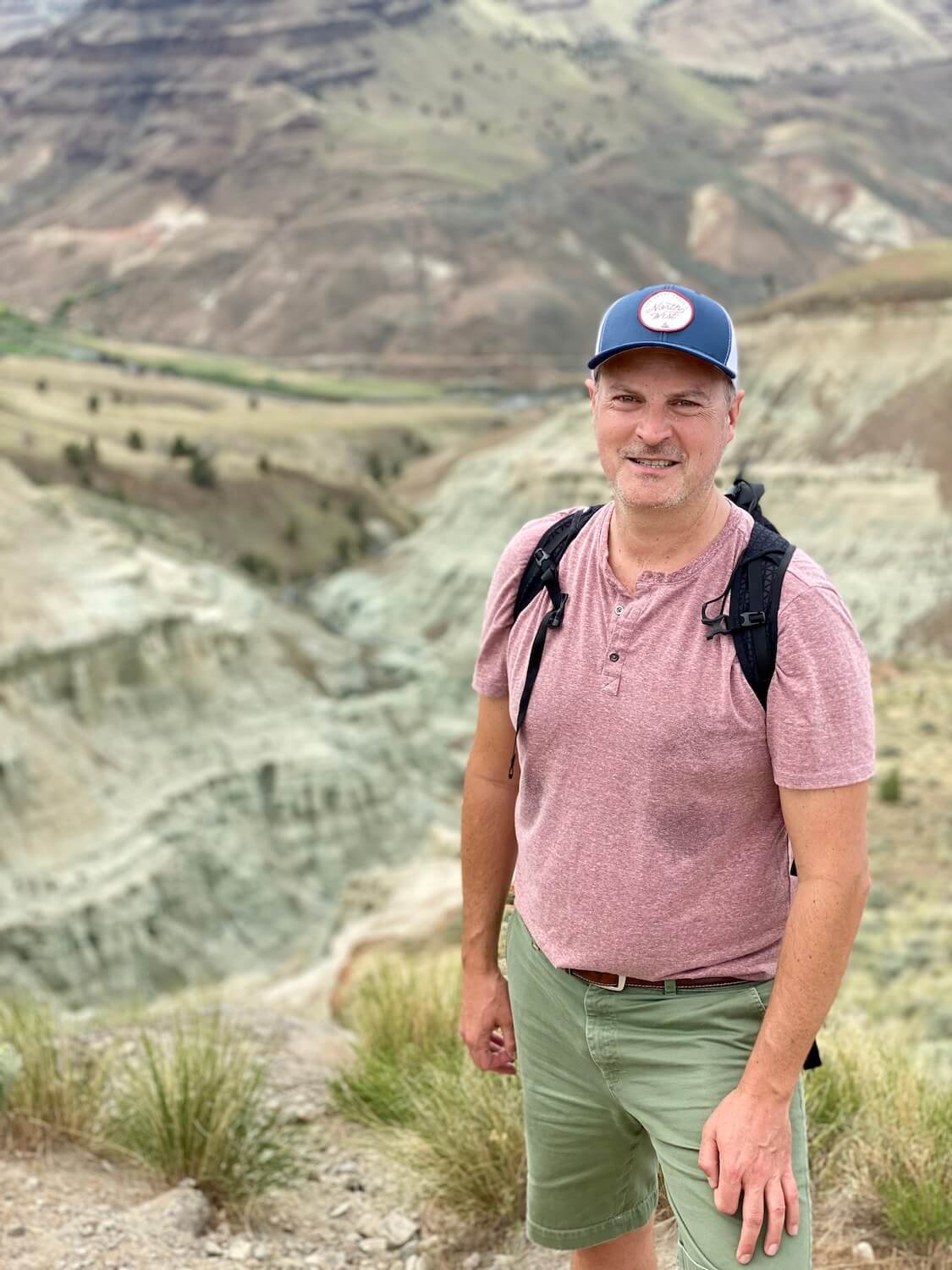
All your questions should be answered in this section offering all kinds of hints for planning your own road trip through Central Oregon. Be sure to save and use the map at the bottom of this article.
Getting to John Day Fossil Beds National Monument

At different times it can be possible to book a motorcoach tour of this part of Oregon. Otherwise, your own transportation is highly recommended to get to and around the National Monument.
Driving to and through Central Oregon
Many people drive through Central Oregon, often from Portland or up/down Highway 97 to/from Crater Lake National Park. The roads around the John Day Fossil Beds National Monument are in excellent condition and are generally wide open. The time estimations below only account for nonstop driving — so adjust your timeline to account for meals, hiking, and other stops.
- The full loop from Portland to the John Day Fossil Beds and back to Portland is a grueling ten hours. It is possible but likely not enjoyable.
- Driving directly to the Painted Hills from the Portland area takes about 4 hours — either via Fossil or Prineville, Oregon.
- The rushed version of visiting all the sights in a one-day loop from the Redmond/Bend area takes about 6 hours.
- Driving to/from Crater Lake National Park to the Painted Hills takes about 3.5 hours each way. If you want to work all three units into the puzzle it becomes a six-hour experience (or 9 hours for the round-trip).
- An itinerary from Redmond/Bend area to Eastern Oregon (Baker City and Interstate 84) via the John Day Fossil Beds is a 7 hour (one-way) investment.
Flying to John Day Fossil Beds
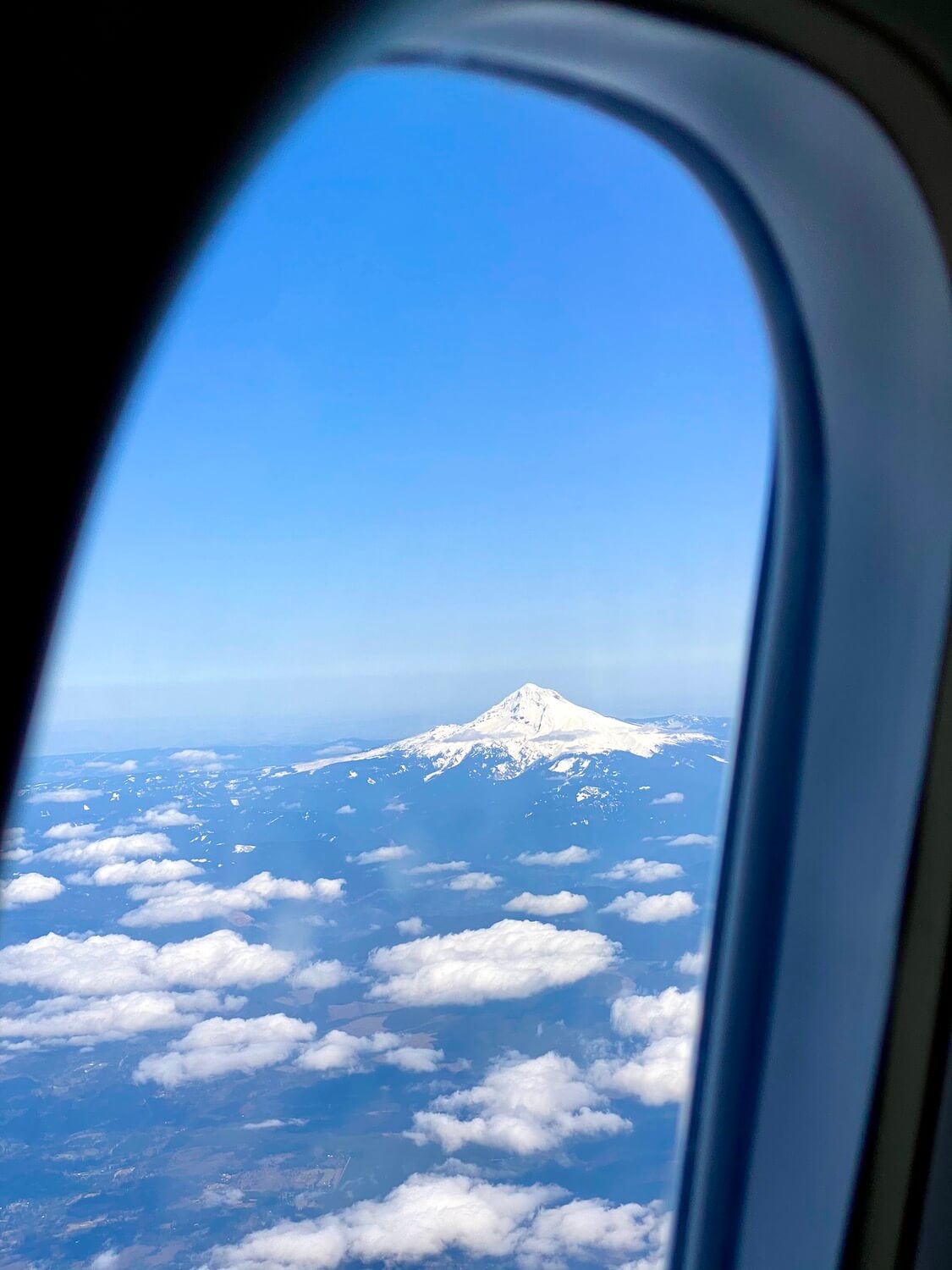
Flying into Central Oregon is a convenient option — using the local Redmond/Bend Airport (RDM) — 70 miles away from the Painted Hills Unit. Scheduled service is operated by Alaska Airlines, American Airlines, Delta Air Lines, and United to a variety of cities on the West Coast (Seattle, Portland, San Francisco, LAX) and even places like Denver and Phoenix.
The benefit of flying into Redmond Airport (RDM) and renting a car is that the drive is only 90 minutes to the Painted Hills with the entire loop taking about six hours, as mentioned above. For the itinerary featured in this article, we flew from Seattle into Redmond and rented a car.
Other airports “near enough” to John Day Fossil Beds:
- Portland International Airport (PDX) — 196 miles
- Boise, Idaho (BOI) — 225 miles to Sheep Rock Unit
- Medford, Oregon (MFR) if including a visit to Crater Lake National Park — 258 miles
By the way, if you’re interested in other options to fly Alaska Airlines on short trips throughout the Pacific Northwest, check out my article, 7 innovative ways to use your gazillion Alaska Airlines miles.
Make time to relax into the quieter pace of rural Oregon

All of the information above doesn’t take into account the time needed to fully experience the different units of the National Monument. For example, the Blue Basin Overlook hike in the Sheep Rock Unit takes a few hours and is a true highlight of the area. The Thomas Condon Paleontology Center is also a worthy use of a few hours.
For this reason (and a true small-town experience), I highly suggest at least one overnight in the area — whether that be Fossil or Mitchell or pitching a tent somewhere in between. There are a number of great campgrounds and every little town has a mercantile stocked with any forgotten provisions. Staying in Mitchell has the added benefit of being conveniently close (9 miles) to enjoying the spiritual experience of dawn or dusk at the Painted Hills. The interactive map featured below has more information on lodging options.
Entrance fees and information for the National Monument
- There are no fees to use the various parking lot areas, but gates close about 30 minutes before/after dawn/dusk.
- No camping is allowed in any of the three units of the monument.
- The John Day Fossil Beds National Monument is open year-round.
- Most of the trails are very short and accessible to people with various mobility levels.
- Pets are allowed on leash in most places.
- Except for the Painted Hills Unit, the main trailheads have clean functioning restrooms and great signage explaining all the particulars of each hike. The Painted Hills services are all at one main restroom/picnic area, near the entrance.
Weather and other environmental information
- I find the weather is best in Spring/Fall. The experience peaks in May, when weather is ideal, terrain flows green, and wildflowers burst into bloom.
- Rattlesnakes are known to exist in these parts, but they prefer to avoid confrontation. Stay on the paths to avoid problems.
- Since the Painted Hills offer an enhanced experience in dawn/dusk conditions I suggest staying overnight near Mitchell, Oregon.
- Wildlife comes out at dusk, including deer and free-range cattle in some places. Be extra careful driving when the sun is setting.
| JOHN DAY FOSSIL BEDS SEASON | MAIN CONSIDERATIONS |
|---|---|
| Winter | Colder, possible inclement driving conditions, shorter days, fewer people, spectacular in snow. |
| Spring | Comfortable weather, variable driving conditions, sunrise/sunset at reasonable hours, green. |
| Summer | Can be very hot, more tourists, longer days, the scenic growing season for a drive, sunrise/sunset at more extreme hours. |
| Fall | Comfortable weather, fall foliage on the drive, sunrise/sunset at reasonable hours. |
Services and other logistical considerations
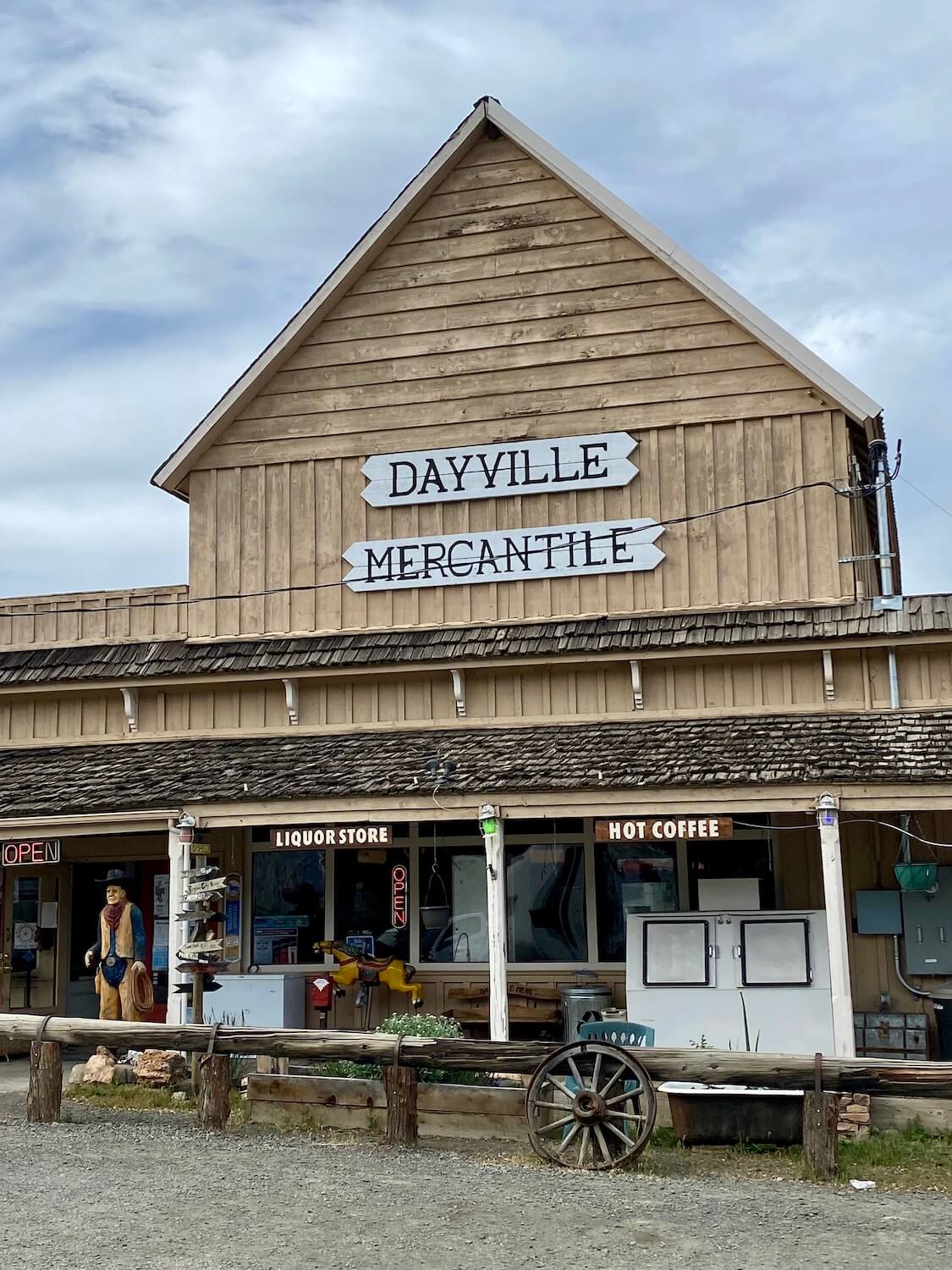
- There are quirky mercantiles in Fossil, Spray, Kimberly, Dayville and Mitchell, Oregon. They seem to sell a little bit of everything.
- Besides camping, I suggest lodging options in Fossil, Spray, and Mitchell, Oregon (featured on the interactive map below).
- Plan fuel stops. Since Oregon law requires gas station employees to pump your gas (some exceptions apply), most stations close around 5-6PM in rural areas. Gas should be available in Fossil, Spray, Kimberly and Dayville, Oregon. Prineville, Oregon offers the only reliable 24-hour service station.
- Cell service is dependent upon carrier, and while fairly strong in Fossil and Mitchell, expect low/no service in most of the areas of the monument.
My other articles about Central Oregon can provide even more information
- Painted Hills, Oregon photos — alive with vibrant red and yellow
- Painted Hills Oregon — everything you need to know to explore
- Weekend getaway to Central Oregon — a great high desert itinerary
- High desert delight — 10 great things to do in Bend Oregon
- Tiger Town Brewing — Surprising kicks on Route 26
- Oregon road trip — photo gallery and helpful tips
Interactive Map of the John Day Fossil Beds drive
Download a checklist
To help aid in planning, I’ve created two checklists: one for flying itineraries and another for a complete road trip. Be sure to save a pdf to your phone or download and print.
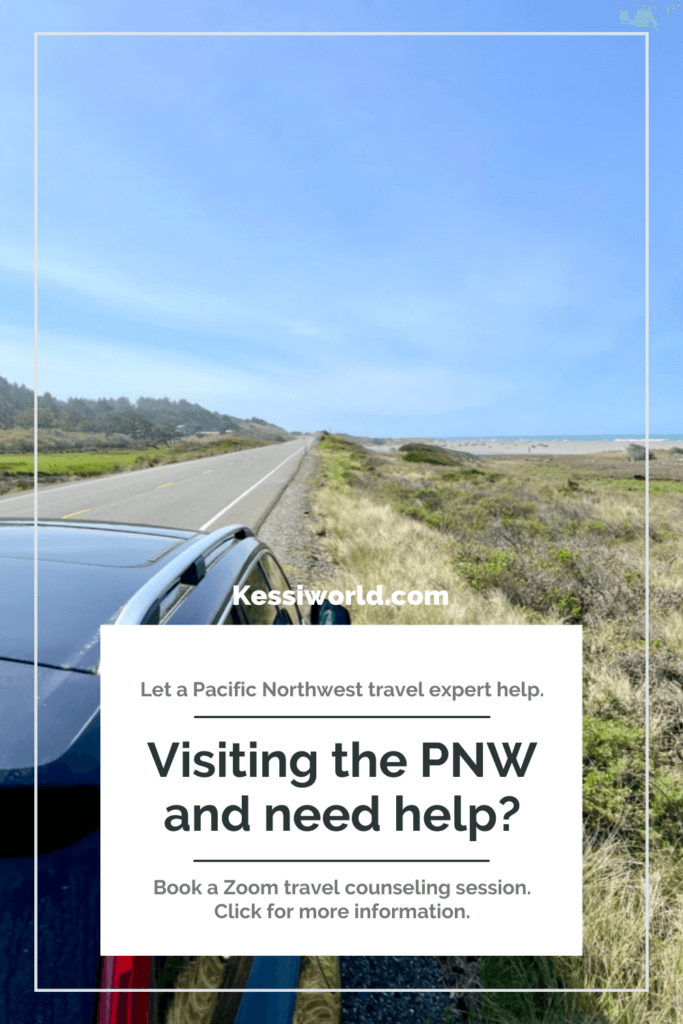
Travel the Pacific Northwest with purpose and meaning.
A lifetime of wandering about Oregon and Washington State gives me powerful practical wisdom to share about travel. And you receive the bonus of my unique mystic connection to the land. I can show you how and where to deepen in nature. This is perfect for:
- First time visitors to the Pacific Northwest.
- Locals hosting out-of-town visitors.
- Those wanting to experience travel + nature + spirit in new ways.
Learn what impedes, supports, and transforms you through Nature Meditation.
Are you stuck in the hamster wheel of daily life, yearning for change but unsure where to start? Are life circumstances overwhelming you, leaving you feeling lost and anxious? Is there a background static of uncertainty holding you back? Welcome to a transformative nature immersion retreat and guided mindfulness experience that will empower you to see your wild nature. You will forever be changed.
